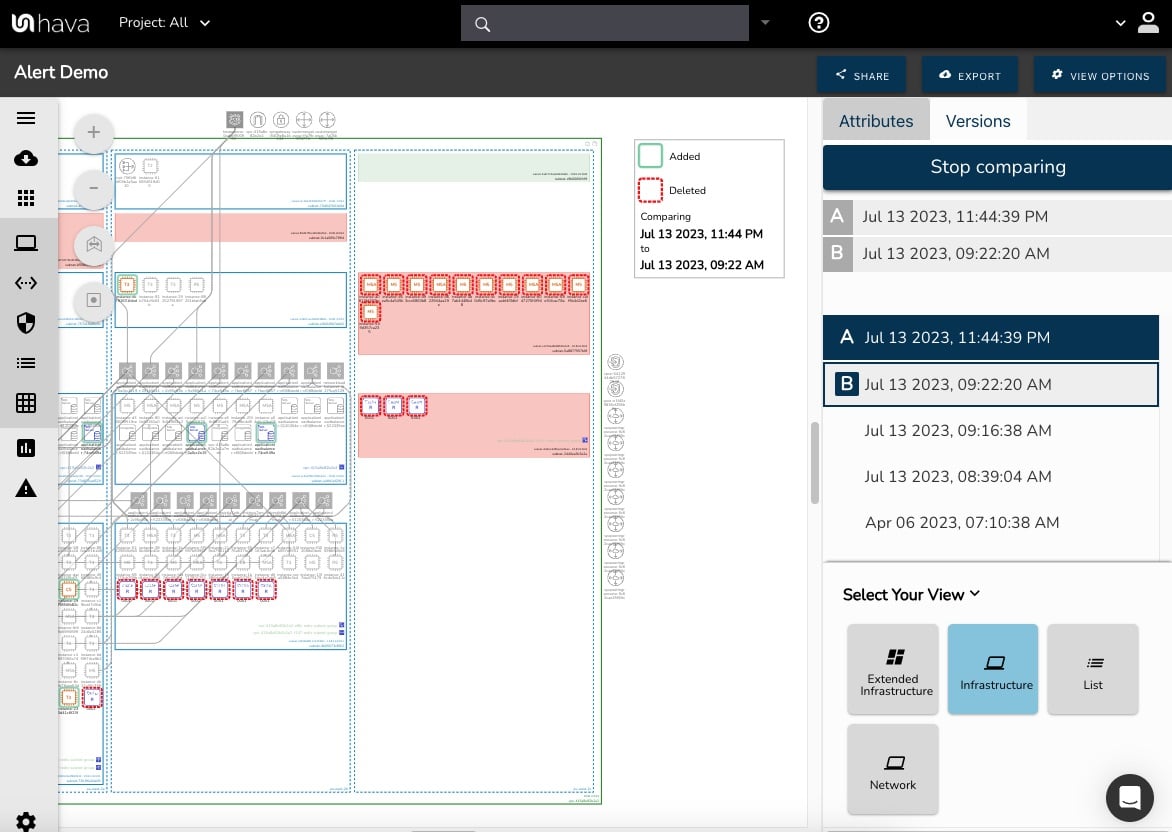In the vast landscape of cloud infrastructure, staying informed about changes in your environment is crucial. With Hava.io's custom search, you can not only create custom diagrams but also set up alerts for these diagrams, ensuring you're always in the loop.
Custom search is more than just a feature; it's a solution to the common problem of managing large and complex cloud environments. With Hava.io, you can build custom diagrams and quickly locate resources from hundreds of cloud accounts. This tool is especially useful when you need to find an individual resource, an IP address, or a VPC running in your managed environments.
One of the key benefits of Hava.io's custom search is its ability to create custom diagrams that self-update. This means you always have the most current view of your cloud infrastructure. But what makes it even more powerful is the ability to set up alerts for changes in your custom diagrams. This keeps you informed and proactive, allowing you to respond quickly to any changes in your cloud environment.
Setting up alerts for custom diagrams is simple. Once you save a custom diagram, it becomes available as a target in Hava's architectural monitoring alerts. You can add the custom diagram as a target so when anything changes on the diagram, you will get an email alert letting you know.
In essence, Hava.io's custom search is a powerful tool that can transform your cloud management experience. It's about turning a sprawling cloud landscape into a navigable map, tailored to your needs. With Hava.io, you can harness the full potential of custom search, taking control of your cloud infrastructure like never before.
Ready to set up alerts for your custom diagrams? Dive into our detailed blog post to learn more about this game-changing tool that lets you create custom diagrams, hybrid diagrams and find resources from amongst hundreds of cloud accounts with a single command.
2 min read
Setting Up Alerts for Hava Custom Diagrams: A Step-by-Step Guide
By Team Hava on Aug 15, 2023 12:20:00 PM
2 min read
Finding the Top 5 Culprits When Cloud Environment Costs Spike
By Alan Blackmore on Aug 7, 2023 4:26:00 PM
How to Find the Top 5 Culprits When Environment Costs Spike using Hava.io
Topics: aws azure gcp FinOps
2 min read
Strategies to Reduce Cloud Architectural Drift and Maintain Security
By Team Hava on Aug 7, 2023 6:00:00 AM
Cloud architectural drift, the divergence between the actual state of a cloud environment and its intended configuration, poses significant challenges to cloud security. It can lead to unauthorized changes, security vulnerabilities, and operational inefficiencies. Therefore, implementing strategies to minimize infrastructure resource drift is crucial for maintaining cloud security.
Firstly, adopting Infrastructure as Code (IaC) is a key strategy. IaC allows the infrastructure to be defined and managed as code, providing a consistent reference point for the desired state of the environment. Regularly running IaC scripts can automatically revert any unauthorized changes, effectively minimizing drift.
Secondly, implementing strict access controls can prevent unauthorized changes that lead to drift. By limiting who can make changes to the cloud environment and requiring approval for changes, organizations can maintain tighter control over their infrastructure.
Thirdly, regular auditing of the cloud environment is essential. Audits can identify changes that have occurred, allowing for the detection and remediation of drift. Tools that provide real-time visibility into the state of the infrastructure can be particularly useful for this purpose.
Additionally, fostering a culture of collaboration and transparency among development teams can help minimize drift. When teams understand the current state of the infrastructure and collaborate on changes, the risk of conflicting changes leading to drift is reduced.
Finally, continuous learning and improvement should be encouraged. As cloud environments and best practices evolve, strategies to minimize drift should be regularly reviewed and updated.
In conclusion, minimizing infrastructure drift is crucial for maintaining cloud security. By adopting IaC, implementing strict access controls, regularly auditing the environment, fostering collaboration, and encouraging continuous improvement, organizations can effectively manage drift and maintain a secure and efficient cloud environment.
Topics: aws azure gcp
2 min read
Understanding Infrastructure Changes: Hava's Superpower for MSPs
By Team Hava on Aug 4, 2023 1:05:00 PM
For Cloud Managed Service Providers (MSPs), understanding and documenting infrastructure changes can be a challenging task. Hava.io, an advanced cloud infrastructure visualization tool, tackles this problem head-on, providing a robust solution for MSPs.
Topics: diagrams msp managed service provider
2 min read
The Role of IaC in Managing Cloud Architectural Drift
By Team Hava on Aug 3, 2023 2:09:28 PM
Infrastructure as Code (IaC) is a key component in modern cloud environments. It allows developers to automate the provisioning and management of cloud resources using code, leading to more efficient and reliable deployments. However, when it comes to managing cloud architectural drift, IaC plays an even more critical role.
Cloud architectural drift refers to the divergence between the actual state of a cloud environment and its intended state as defined by IaC scripts. This drift can occur due to manual changes, conflicting IaC scripts, or other factors. If left unchecked, it can lead to security vulnerabilities, operational inefficiencies, and other issues.
IaC can help manage cloud architectural drift in several ways. Firstly, by defining the desired state of the cloud environment in code, IaC provides a clear and consistent reference point. Any deviations from this reference point can be easily identified, allowing for quick detection of drift.
Secondly, IaC enables automated remediation of drift. By running IaC scripts regularly, any changes to the cloud environment that were not made through IaC can be automatically reverted, bringing the environment back to its desired state. This not only reduces the risk of drift but also frees up valuable time for IT teams.
Finally, IaC promotes transparency and collaboration. With the entire infrastructure defined in code, it's easier for teams to understand the current state of the environment, track changes, and collaborate on updates. This can help prevent conflicting changes that could lead to drift.
In conclusion, IaC is an essential tool for managing cloud architectural drift. By defining the desired state of the cloud environment in code, enabling automated remediation, and promoting transparency, IaC can help organizations maintain control over their cloud environments, reduce risks, and improve operational efficiency.
Topics: aws azure gcp drift
2 min read
Understanding the Causes and Effects of Cloud Infrastructure Drift
By Team Hava on Aug 3, 2023 1:17:37 PM
Infrastructure drift is a common challenge faced by organizations that rely heavily on cloud services. It refers to the divergence of the actual state of cloud resources from their prescribed Infrastructure as Code (IaC) configuration. This drift can lead to potential security risks and operational challenges, making it crucial for businesses to understand its causes and effects.
The causes of infrastructure drift are varied and can occur due to several factors. Manual changes, such as configuration modifications, software updates, hardware malfunctions, and human error, can all lead to drift. These changes can impact the production environment, leading to discrepancies between the actual and intended state of the infrastructure.
Another common cause of infrastructure drift is conflicting Infrastructure as Code (IaC) code. This can occur when multiple development teams are working on the same infrastructure, leading to inconsistencies and drift. Poor practices, inappropriate permissions, and overlapping team boundaries can further contribute to drift. These issues can lead to unmanaged resources, creating a gap between the actual and desired state of the infrastructure.
The effects of infrastructure drift can be severe and far-reaching. Unmanaged drift can lead to security breaches, ransomware attacks, financial losses, increased resource costs, and increased support costs. It can also cause deployment failures due to configuration issues. These consequences can greatly affect critical cloud services and cloud security in cloud environments.
One of the key factors contributing to deployment failure is infrastructure drift. Therefore, managing infrastructure drift is essential to maintain system stability. Alterations to the configuration of code can potentially lead to infrastructure failure, causing infrastructure drift.
In conclusion, understanding the causes and effects of infrastructure drift is crucial for organizations relying on cloud services. By identifying the factors contributing to drift and the potential consequences of unmanaged drift, organizations can implement effective strategies to manage drift. This can help maintain the security and reliability of their cloud infrastructure, ensuring smooth operations and avoiding costly security breaches.
Topics: aws azure gcp msp managed service provider
2 min read
Scanning for and deleting unused cloud services - Hava brings context
By Team Hava on Jul 28, 2023 4:03:00 PM
Scanning for and Deleting Unused Cloud Services: A Key to Cost Efficiency with Hava.io
Topics: aws azure gcp FinOps
2 min read
Automating Your Custom Cloud Infrastructure Diagrams with Hava
By Alan Blackmore on Jul 28, 2023 11:48:00 AM
In the complex landscape of cloud infrastructure, maintaining up-to-date diagrams can be a daunting task. However, with Hava.io's custom search, you can automate your cloud infrastructure diagrams, ensuring you always have the most current view of your cloud environment.
Custom search is more than just a feature; it's a solution to the common problem of managing large and complex cloud environments. With Hava.io, you can build custom diagrams and quickly locate resources from hundreds of cloud accounts. This tool is especially useful when you need to find an individual resource, an IP address, or a VPC running in your managed environments.
One of the key benefits of Hava.io's custom search is its ability to create custom diagrams that self-update. This means you always have the most current view of your cloud infrastructure. Additionally, you can set up alerts for changes in your custom diagrams, keeping you informed and proactive.
But the power of custom search doesn't stop there. With Hava.io, you can also perform deep searches that not only bring back the resources that match your search but also anything connected to those resources. This is particularly useful when you want to see all the resources connected to a particular instance in your VPC or virtual network.
In essence, Hava.io's custom search is a powerful tool that can transform your cloud management experience. It's about turning a sprawling cloud landscape into a navigable map, tailored to your needs. With Hava.io, you can harness the full potential of custom search, taking control of your cloud infrastructure like never before.
Ready to automate your cloud infrastructure diagrams? Dive into our detailed blog post to learn more about this game-changing custom diagram and multi cloud single point search tool. <---
Topics: aws cloud search
2 min read
Navigating the Cloud with Ease: How Hava’s Interactive Diagrams Simplify AWS and Azure Security
By Team Hava on Jul 24, 2023 2:26:00 PM
Topics: aws security
2 min read
How Hava.io's Version History Facilitates Better Cloud Architecture Management
By Team Hava on Jul 24, 2023 12:51:00 PM
For Cloud Managed Service Providers (MSPs), maintaining a thorough and up-to-date record of client documentation is paramount. Hava.io, an innovative cloud infrastructure visualization tool, offers a unique solution to this with its version history feature, bringing unprecedented clarity and continuity to cloud infrastructure management.









